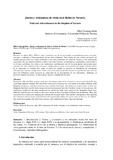Mostrar el registro sencillo del ítem
Juicios y ordenanzas de visita en el Reino de Navarra
| dc.creator | Lizarraga Rada, Mikel | es_ES |
| dc.date.accessioned | 2022-02-04T12:25:02Z | |
| dc.date.available | 2022-02-04T12:25:02Z | |
| dc.date.issued | 2021 | |
| dc.identifier.issn | 2255-2707 | |
| dc.identifier.uri | https://hdl.handle.net/2454/42115 | |
| dc.description.abstract | Durante los siglos XVI y XVII la visita constituyó uno de los principales procedimientos para controlar, corregir o reformar el funcionamiento de los altos tribunales. Será objeto de este trabajo presentar un estudio general sobre las visitas realizadas a los altos tribunales del reino de Navarra y sus ordenanzas resultantes. En un contexto histórico como el del reino navarro, recientemente conquistado y anexionado a la Corona castellana, las visitas y sus ordenanzas constituyeron uno de los principales mecanismos para reformar los altos tribunales navarros que, configurados en torno a una jurisdicción propia, distaba mucho de la imperante en Castilla. Por tanto, el objeto de estudio se centrará en vislumbrar las principales reformas que trajeron consigo estas visitas y las consecuencias jurisdiccionales y organizativas que tuvieron para los tribunales reales navarros la aplicación de lo preceptuado en sus ordenanzas. Asimismo, se prestará especial atención a la observancia, fuerza y compilación de estas. | es_ES |
| dc.description.abstract | During the XVI and XVII century, visits were the primary procedure to control, correct and reform the way royal high tribunals worked. The aim of this research is to analyse the visits made in the high tribunals of the Kingdom of Navarre and the ordinances that resulted from them. The historical context refers to that of a Kingdom that had recently been conquered and incorporated into the Castilian crown. In that process, the ordinances worked as the main mechanism to reform the high royal courts of the Kingdom, which were different from the ones in Castile as they were based on their own legal tradition and jurisdiction. Thus, this research article focuses on studying the reforms that brought those visits and the consequences that applying the ordinances had in terms of jurisdiction and organization within the royal courts in Navarre. In addition, this work also examines the observance, power and compilation of these legal mechanisms. © 2021, Institute for Social, Political and Legal Studies. | en |
| dc.format.extent | 30 p. | |
| dc.format.mimetype | application/pdf | en |
| dc.language.iso | spa | en |
| dc.publisher | Instituto de Estudios Sociales, Políticos y Jurídicos | |
| dc.relation.ispartof | Glossae, 18, 2021, pp. 276-305 | |
| dc.rights | © 2022 Glossae. Con permiso del editor | en |
| dc.subject | Visitas | es_ES |
| dc.subject | Reino de Navarra | es_ES |
| dc.subject | Siglo XVI | es_ES |
| dc.subject | Ordenanzas de visita | es_ES |
| dc.subject | Reforma de los tribunales reales navarros | es_ES |
| dc.subject | Kingdom of Navarre | en |
| dc.subject | Reform of the royal courts from Navarre | en |
| dc.subject | Visit ordinances | en |
| dc.subject | Visits | en |
| dc.subject | XVI century | en |
| dc.title | Juicios y ordenanzas de visita en el Reino de Navarra | es_ES |
| dc.title.alternative | Trial and visit ordinances in the Kingdom of Navarre | en |
| dc.type | info:eu-repo/semantics/article | en |
| dc.type | Artículo / Artikulua | es |
| dc.contributor.department | Institute for Advanced Social Research - ICOMMUNITAS | es_ES |
| dc.rights.accessRights | info:eu-repo/semantics/openAccess | en |
| dc.rights.accessRights | Acceso abierto / Sarbide irekia | es |
| dc.type.version | info:eu-repo/semantics/acceptedVersion | en |
| dc.type.version | Versión aceptada / Onetsi den bertsioa | es |


